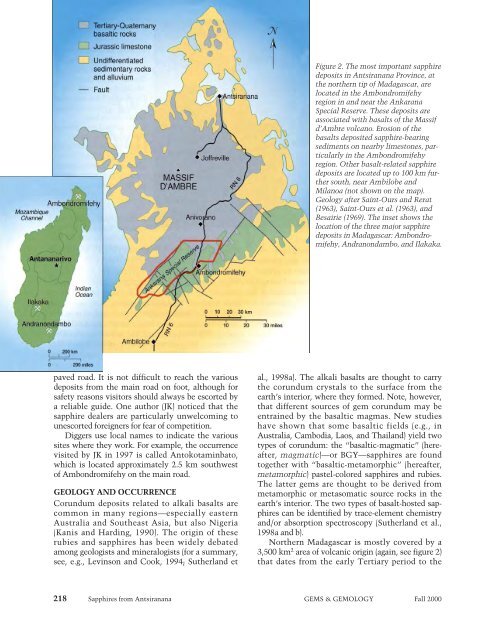Fall 2000 Gems & Gemology - Gemfrance
Fall 2000 Gems & Gemology - Gemfrance
Fall 2000 Gems & Gemology - Gemfrance
You also want an ePaper? Increase the reach of your titles
YUMPU automatically turns print PDFs into web optimized ePapers that Google loves.
paved road. It is not difficult to reach the various<br />
deposits from the main road on foot, although for<br />
safety reasons visitors should always be escorted by<br />
a reliable guide. One author (JK) noticed that the<br />
sapphire dealers are particularly unwelcoming to<br />
unescorted foreigners for fear of competition.<br />
Diggers use local names to indicate the various<br />
sites where they work. For example, the occurrence<br />
visited by JK in 1997 is called Antokotaminbato,<br />
which is located approximately 2.5 km southwest<br />
of Ambondromifehy on the main road.<br />
GEOLOGY AND OCCURRENCE<br />
Corundum deposits related to alkali basalts are<br />
common in many regions—especially eastern<br />
Australia and Southeast Asia, but also Nigeria<br />
(Kanis and Harding, 1990). The origin of these<br />
rubies and sapphires has been widely debated<br />
among geologists and mineralogists (for a summary,<br />
see, e.g., Levinson and Cook, 1994; Sutherland et<br />
Figure 2. The most important sapphire<br />
deposits in Antsiranana Province, at<br />
the northern tip of Madagascar, are<br />
located in the Ambondromifehy<br />
region in and near the Ankarana<br />
Special Reserve. These deposits are<br />
associated with basalts of the Massif<br />
d’Ambre volcano. Erosion of the<br />
basalts deposited sapphire-bearing<br />
sediments on nearby limestones, particularly<br />
in the Ambondromifehy<br />
region. Other basalt-related sapphire<br />
deposits are located up to 100 km further<br />
south, near Ambilobe and<br />
Milanoa (not shown on the map).<br />
Geology after Saint-Ours and Rerat<br />
(1963), Saint-Ours et al. (1963), and<br />
Besairie (1969). The inset shows the<br />
location of the three major sapphire<br />
deposits in Madagascar: Ambondromifehy,<br />
Andranondambo, and Ilakaka.<br />
al., 1998a). The alkali basalts are thought to carry<br />
the corundum crystals to the surface from the<br />
earth’s interior, where they formed. Note, however,<br />
that different sources of gem corundum may be<br />
entrained by the basaltic magmas. New studies<br />
have shown that some basaltic fields (e.g., in<br />
Australia, Cambodia, Laos, and Thailand) yield two<br />
types of corundum: the “basaltic-magmatic” (hereafter,<br />
magmatic)—or BGY—sapphires are found<br />
together with “basaltic-metamorphic” (hereafter,<br />
metamorphic) pastel-colored sapphires and rubies.<br />
The latter gems are thought to be derived from<br />
metamorphic or metasomatic source rocks in the<br />
earth’s interior. The two types of basalt-hosted sapphires<br />
can be identified by trace-element chemistry<br />
and/or absorption spectroscopy (Sutherland et al.,<br />
1998a and b).<br />
Northern Madagascar is mostly covered by a<br />
3,500 km 2 area of volcanic origin (again, see figure 2)<br />
that dates from the early Tertiary period to the<br />
218 Sapphires from Antsiranana GEMS & GEMOLOGY <strong>Fall</strong> <strong>2000</strong>


